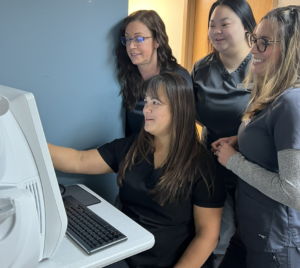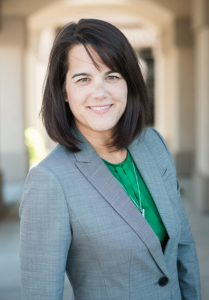
Dr. Murphy shows test results generated by ZEISS CIRRUS to her support staff team. The depth of information made possible by the technology’s Advanced Retinal Pigment Epithelial Analysis (RPE) makes a higher level of patient care possible.
An AMD and Geographic Atrophy Tool Kit
Sponsored Content
By Mary Anne C. Murphy, OD
Dec. 13, 2023
There are OCTs, and then there are OCTs. This already impressive instrumentation becomes indispensable with Advanced Retinal Pigment Epithelial (RPE) Analysis capability. Here are the details on the OCT we have in our office, ZEISS CIRRUS, that includes unique functionality, including how it elevates my ability to care for patients we previously could simply do nothing for.
Effectively and Efficiently Diagnose & Manage Your AMD Patients with Ease
Age-related macular degeneration is common in all practices, especially my own. A great advantage of having an OCT with a dedicated RPE analysis is that it helps me better manage these patients.
It is extremely useful to determine the relative progression of drusen as it relates to geographic atrophy (GA). With new FDA-cleared AMD therapies available, monitoring for change in the severity of GA becomes essential to protecting our patient’s vision. ZEISS CIRRUS’s Advanced RPE Analysis allows us to do this quickly and efficiently, and integrates seamlessly into our current patient flow.
Given that ZEISS CIRRUS’s advanced RPE analysis is already included in the instrument/software, and that we have it at no additional cost, is really the icing on the cake!
Create a Practice Capable of Delivering Advanced Medical Eyecare
Having this functionality takes my ability to evaluate a patients GA progression to a level which is far and above what I would have thought possible within the realm of today’s busy practice. In the past, this type of analysis would require analyzing multiple documents spread out across my monitor and manually comparing data from one to the next – an arduous task when you have seen a patient for years (so much data!) and when you have a full docket of patients waiting.
Advanced RPE analysis allows me, without having to do any extra data capture, to see the data on the fly and provides a progression analysis that allows me to make decisions quickly about whether or not the patient’s GA has progressed and if that progression warrants referral for newly available treatments.
Often, when reviewing images, when multiple parafoveal large drusen are growing both in breadth and height, it can be difficult to determine true rate of growth. Because the Advanced RPE Analysis on my CIRRUS measures volumetric changes and trends, the data is much easier to evaluate.
Learn About the Power You May Already Have At Your Fingertips
I have been an avid ZEISS OCT user for more than two decades. When the instrument was first introduced, I sat with my ZEISS field trainer, took advice from my peers and informed my techs which data sets and scans I wanted. In all honestly, until the AngioPlex OCTA was released, I never re-evaluated my instructions. After OCTA, we started capturing more data and generating additional analytical scans, but unless the doctor is AWARE that these analytical scans exist, they would never know to order them!
I recently sat in a lecture at Vision Expo West where a well-respected mentor lectured on retina, and one of his slides showed the ZEISS Advanced RPE Analysis. I was blown away. He is in an academic environment and has been a ZEISS key opinion leader for years, so I assumed he had access to elements of the software that were new or not available to me. I approached him afterward to ask, and he was the one who let me know it had been there all along!
When I cowered with humility he kindly reassured me – prior to some of the new GA treatments, having the data didn’t really change our course of treatment. Today, it does. You can have a toolbox full of tools in the garage, but until you have a project, they really serve no purpose.
Enhance Your Ability to Effectively Keep Patients In-Office & Co-Manage When Necessary
Once back at my office, I was able to mine my database for my dry AMD patients and generate the RPE Analysis from data I had previously captured. As my technicians did this, I had them flag any scans that met my criteria so I could evaluate them personally. These patients will come in sooner than previously recommended.
This data analysis has resulted in more active dialogue with my retinal specialist ophthalmology partners. I work with several and am in the process of trying to understand what their personal thresholds are for referral and treatment as it relates to GA. Some are aggressive and some are conservative – though they have all stated that they expect their thresholds to change as they gain more experience with the treatments. They are grateful for our high level of care, and given their busy schedules, appreciate that we are capable of continuing to care for those patients who do not meet their criteria for treatment or referral.
Brand Your Practice as the Place to Come to for Cutting-Edge Care
Our practice prides itself on having the best of the best when it comes to the industry’s diagnostic instrumentation. Our patients have come to expect it. From a patient perspective, nothing has changed when it comes to data collection via RPE analysis. They are not sitting down to an additional instrument or having additional scans. How many times do we hear, “Oh I haven’t done this one before!”
Read Another Success Story
Therefore, it is imperative that the provider share the data gathered from RPE analysis with the patient. The output is clean and easy to interpret, and my patients find it fascinating. For years, we have told our dry AMD patients that there was not much we could do as their condition changed. While not every patient qualifies for the new treatments, it is critical that we explain to our patients what criteria we are looking for and to let them know that new treatments are constantly on the horizon. Returning for monitoring visits is more important than ever.
Patient Compliance is Key to Better Outcomes
When patients understand the value of monitoring visits for diagnosed eye diseases, they don’t miss them. They send their friends. They trust. It’s that simple. Often we are looking for the hidden secret when it comes to being more profitable. I don’t think its a secret – do what’s in the best interest of the patient and they will return.
When you are monitoring a glaucoma patient and things start changing more rapidly, you see them more often. The same has always been true for our dry AMD patients, but mostly because we have been concerned about their conversion to wet AMD, using the AngioPlex (OCTA) function within our CIRRUS device. Now we are specifically searching for smaller changes as they pertain to the thresholds for treatment for GA, so having the advanced RPE Analysis allows me to objectively evaluate that data quickly.
ZEISS CIRRUS with its advanced RPE Analysis for diagnosing and monitoring our non-exudative (dry) AMD patients, and AngioPlex OCTA for monitoring those patients converting to exudative (wet) AMD, forms a powerful AMD & GA Tool Kit that empowers me to efficiently gather all the high-level information I need to diagnose and monitor eye disease. Our patients know our office is the place to come for the very best medical eyecare.
 Mary Anne C. Murphy, OD, is the owner of Front Range Eye Associates in Broomfield, Colo. To contact her: DrMurphy@fr-ea.com
Mary Anne C. Murphy, OD, is the owner of Front Range Eye Associates in Broomfield, Colo. To contact her: DrMurphy@fr-ea.com

























